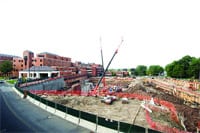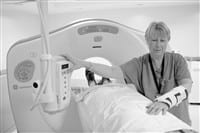Baystate Building Project Moves Forward in Construction and Financing
SPRINGFIELD — Baystate Medical Center took two major steps toward the future recently, launching foundation work for its planned $246 million construction project and completing a successful foray into the municipal bond market, a major part of the project’s financing.
The expansion, dubbed the ‘Hospital of the Future’ project, is on schedule for an expected completion in 2012, said Mark Tolosky, president and CEO of Baystate Health, in noting that investors snapped up $135 million of Baystate Medical Center bonds in a matter of hours during a recent offering as demand for the financing instruments far exceeded supply.
“In many ways, this offering was a test of our organization’s strength and planning. Clearly, investors liked what they saw in Baystate Health,” Tolosky said. “This project means so much to our city and to our community, in terms of quality health care in the coming decades and economic opportunity right now.”
Site preparation for the new facility commenced last summer, and foundation work is now underway. According to Baystate officials, the nearly 600,000-square-foot building will include:
- A dedicated, state-of-the-art Heart and Vascular Center;
- Single-bed patient rooms designed with the guidance of patients, families, and clinical staff to support as restful and comforting a hospital stay as possible;
- The latest standards for environmentally responsible building, including recycled materials and a rooftop green space; and
- $9.6 million in new community-benefit initiatives for Springfield related to the project.
Baystate Health is a not-for-profit health system; the municipal bonds are in essence approval for a $135 million ‘mortgage’ for the new construction and the largest funding source for the $246 million project.
The project is also benefiting from $70 million in new market tax credits, which support construction projects in low-income neighborhoods. Baystate’s building project will stimulate the local economy and bring job opportunities. It is estimated that the new facility will bring more than 300 jobs to area trades workers during construction, and 550 permanent clinical and physician positions when completed.
The project still needs $40 million in funding, and that money is expected to come from government sources, philanthropic giving, and Baystate Health capital funds. Baystate Medical Center is working with Gov. Deval Patrick’s office and the Legislature to identify economic-development funds that this shovel-ready construction project could utilize.
To ensure the most responsible use of financial resources, Baystate officials said, the plan for the project has remained flexible and attuned to the broader health care and fiscal environment. Baystate Health has lowered the cost of the project by $13 million with minor revisions to the original plan.
“We move forward,” Tolosky said, “continuing our unwavering focus on our patients to ensure that we provide the best health care to our communities in Western Mass., now and for generations to come.”
The new construction makes use of existing land adjacent to Springfield Street and Medical Center Drive. The project, which will include the addition of a new, multi-story building connected to existing facilities, will include the replacement and expansion of medical/surgical and intensive care beds and inpatient heart and vascular procedure areas, and the relocation of critical care beds currently located in the hospital’s East Wing, making space available for administrative and improved non-clinical support services. The completion of the project will expand the hospital’s current 653 licensed beds to 701.
Baystate’s plans mirror a nationwide need for hospitals to update their facilities, many of which were constructed or upgraded in the 1950s. Factors contributing to the need for new facilities, hospital officials said, include:
• An aging population, including the first wave Baby Boomers reaching their 60s, which will require more inpatient care and services than the hospital now has the capacity to deliver;
• Disease prevalence related to heart and vascular disease, cancer, neurological disease, and obesity, which is expected to rise as the population ages; and
• Today’s patients requiring new environments and technologies that cannot be properly accommodated in smaller, older procedure rooms, as well as a nationwide trend to switch to private patient rooms to support best practice in infection control, and that offer more space to accommodate medical equipment and family involvement.




Comments are closed.